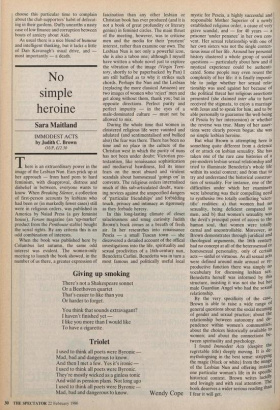No simple heroine
Sara Maitland
IMMODEST ACTS by Judith C. Brown
OUP, £12.50
There is an extraordinary power in the image of the Lesbian Nun. Ears prick up at her approach — from hard porn to hard feminism, with disapproval, distress and disbelief in between, everyone wants to know. When Breaking Silence, a collection of first-person accounts by lesbians who had been or (in markedly fewer cases) still were in religious orders, was published in America by Naiad Press (a gay feminist house), Forum magazine (an 'up-market' product from the Penthouse stable) bought the serial rights. By any criteria this is an odd combination of interests.
When the book was published here by Columbus last autumn, the same odd interest was evident. The women-only meeting to launch the book showed, in the number of us there, a greater expression of fascination than any other lesbian or Christian book has ever produced (and it is not a book of great profundity or literary genius) in feminist circles. The main thrust of the meeting, however, was to criticise men and the media for their 'prurient' interest, rather than examine our own. The Lesbian Nun is not only a powerful icon, she is also a taboo one; although I myself have written a whole novel just to explore the vibration of the image (Virgin Terri- tory, shortly to be paperbacked by Pan) I am still baffled as to why it strikes such chords. Perhaps the Nun and the Lesbian (replacing the more classical Amazon) are two images of women who 'reject' men and get along without them, thank you; but in opposite directions. Perfect purity and perfect impurity — in the eyes of a male-dominated culture — must not be allowed to mix.
During the whole time that women in cloistered religious life were vaunted and adulated (and sentimentalised and bullied also) the fear was there. There has been no time and no place in the culture of the Christian west in which the purity of nuns has not been under doubt: Victorian Pro- testantism, like renaissance sophistication and mediaeval bawdiness, fed its inner fears on the most absurd and virulent scandals about homosexual 'goings on' in convents. The religious orders internalised much of this sub-articulated doubt, warn- ing novices against the unspecified dangers of 'particular friendships' and forbidding touch, privacy and intimacy as rigorously as they forbade heresy.
In this long-lasting climate of closet salaciousness and smug curiosity Judith Brown's book comes as a breath of fresh air. In her researches into renaissance Pescia — a small Tuscan town — she discovered a detailed account of the offical investigations into the life, spirituality and sexual proclivities of a 16th-century nun, Benedetta Carlini. Benedetta was in turn a most famous and politically useful local mystic for Pescia, a highly successful and responsible Mother Superior of a newly established religious order, a cause of very grave scandal, and — for 40 years — a prisoner 'under penance' in her own con- vent. Her sexual relationship with one of her own sisters was not the single conten- tious issue of her life. Around her personal history clustered a whole group of social questions — particularly about how and if mystical experience could be authenti- cated. Some people may even resent the complexity of her life: it is finally impossi- ble to judge whether her sexual rela- tionship was used against her because of the political threat her religious assertions presented (she claimed inter alia to have received the stigmata, to enjoy a marriage with Jesus and to speak for him, and to be able personally to guarantee the well-being of Pescia by her intercession) or whether the reverse was true. Many of her asser- tions were clearly proven bogus: she was no simple lesbian heroine.
But what Brown is attempting here is something quite different from a defence of or attack on lesbian sexuality. She has taken one of the rare case histories of a pre-modern lesbian sexual relationship and tried to illuminate Benedetta's whole life within its social context; and from that to try and understand the historical construc- tion of sexuality. For instance, one of the difficulties under which her examiners were labouring was their compelling need to synthesise two totally conflicting 'scien- tific' realities: a) that women had no sexuality, being deficient compared to men, and b) that women's sexuality was the devil's principal point of access to the human soul, that women were totally carnal and uncontrollable. Moreover, as Brown demonstrates through juridical and theological arguments, the 16th century had no concept at all of the heterosexual or homosexual personality, only of certain acts — sinful or virtuous. As all sexual acts were defined around male arousal or re- productive function there was simply no vocabulary for discussing lesbian sex. Benedetta herself was informed by this structure, insisting it was not she but her male Guardian Angel who had the sexual relationship.
By the very specificity of the case, Brown is able to raise a wide range of general questions about the social meaning of gender and sexual practice; about the relationship between autonomy and de- pendence within women's communities; about the choices historically available to women; and about the connections be- tween spirituality and psychology. I found Immodest Acts (despite the regretable title) deeply moving. It is de- mythologising in the best sense: stripping the magic (black or white) from the image of the Lesbian Nun and offering instead one particular woman's life in its specific historical context. Brown writes lucidly and lovingly and with real attention. The book deserves a wider serious reading than I fear it will get.














































 Previous page
Previous page